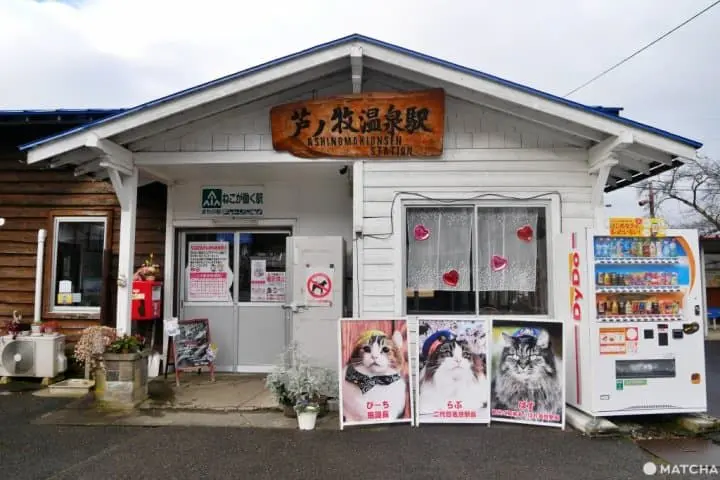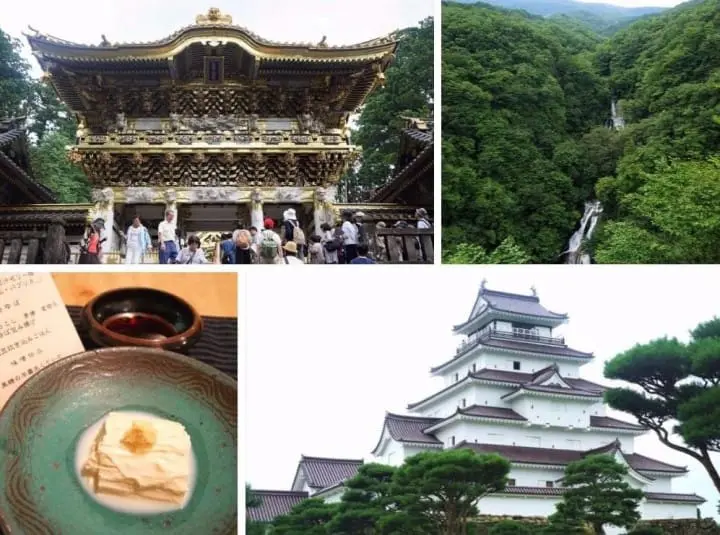Aizu-Wakamatsu, Fukushima: A Two-Day Winter Trip Of Food, History, And Cats

Aizu-Wakamatsu is a beautiful castle town in Fukushima. From Tsuruga Castle to a feline station master, there is so much to see in this history-packed destination! Visitors can also admire the stunning seasonal scenery in winter.
Savor Food and Culture in Aizu-Wakamatsu!
Aizu-Wakamatsu, located in Fukushima Prefecture, is famous for its spectacular snowscapes seen aboard local trains. Historically, the city was a crucial point between Edo (modern-day Tokyo) and the Tohoku region. You can find elements of Edo culture still preserved in places such as Ouchi-juku, an important stopover point.
Let's embark on a two-day trip to Aizu-Wakamatsu to experience some of its best food and culture!
Day One: Castle Town and Ashinomaki Onsen
Aizu-Wakamatsu is a two to three-hour ride aboard the Shinkansen (bullet train) or JR train from Tokyo or Sendai. Though it may seem a bit far, this is one of the reasons why the area has successfully preserved its historical towns.
We'll start our trip at the historic castle town. The closest station is Nanokamachi Station on the Aizu Railway line, but you can take a bus departing from JR Aizu-Wakamatsu Station here, too.
Stroll Through a Historic Town
The neighborhoods along Nanokamachi-dori and Noguchi Hideyo Seishun Street originally comprised the castle town. The buildings that stand today are from 50 to over 100 years old. Built during the Meiji, Taisho, and Showa eras, these historic buildings add a unique atmosphere to the town.

The Suehiro Sake Brewery is a well-known sake distillery (*) in Aizu-Wakamatsu that offers tours and tastings. The architecture of the warehouse merges styles spanning through the Meiji, Taisho, and Showa periods.
The brewery's cafe serves desserts made with in-house sake. The cakes are a great way to get a taste of sake for those who can't drink alcohol.
Website: https://www.sake-suehiro.jp/kurakoubou/access.html (Japanese)
*Sake: alcoholic beverage made from rice.

Shirokiya Lacquerware embodies the design aesthetics of Taisho Romanticism. The off-white exterior, tinted with charcoal gray, takes influence from western architectural styles. Meanwhile, the inside uses the "dozo" (warehouse made of soil) technique—a common Aizu style—that blends Japanese and Western architecture.
The lacquerware sold inside the store is sublime, each made with great care and hand-painted by artisans.
Website: https://www.shirokiyashikkiten.com/english/index.html

The third store on our list is the long-established dessert shop Nagatoya. The store's commitment to bridge the old and the new is reflected in their newly-renovated building and wagashi (traditional Japanese sweets).
We recommend the Kaguno-Kinomi, which uses a rare Aizu walnut, and the Fly Me to the Moon Yokan Fantasia, a colorful red bean paste dessert.
Website: http://www.nagatoya.net/en-about

You can try a local dish known as meppa-meshi at Ryoriryokan Tagoto. The dish consists of steamed rice topped with a variety of ingredients. Each bite brings forth a burst of flavors!
The lunch portion is large and might be too much to finish in one sitting. Luckily, the restaurant will make rice balls for restaurant-goers to take out.
We highly suggest the wild vegetable meppa-meshi!
Website: http://tagoto-aizu.com/en/index.html

Our next stop is Aizu Ichiban-kan. The building used to be Kaiyo Hospital, where the renowned Japanese doctor Hideyo Noguchi underwent surgery. It has since been converted into a stylish cafe.
We recommend ordering the Aizu Honey Coffee. With the beans roasted on-site, the freshly-brewed cup of coffee comes with a small bottle of local honey. Any leftover honey can be taken home.
Website: http://www.uyou.gr.jp/aizu-ichibankan/index.html (Japanese)

There are countless more shops and buildings, each with their own unique story, along these historic streets. There is plenty to enjoy just strolling through the town.
From Nishi-Wakamatsu Station to Ashinomaki Onsen Station
After exploring the historic streets of Aizu-Wakamatsu, it's time to relax in an onsen (hot spring)! We'll take the Aizu Railway from Nishi-Wakamatsu Station to Ashinomaki Onsen Station. It is roughly a 15-minute train ride.

Before boarding the train, purchase the Ouchi-juku Common Discount Ticket at the station's ticket window. This will allow us to take the Aizu Railway to Ouchi-juku and give us free rides on the Saruyugo shuttle bus for a day. It is a must-have item for our trip!
Both the one-way ticket and the round trip ticket are available for purchase. We opted for the round trip.
| Ouchi-juku Common Discount Ticket |
One-way/Round trip ticket for Aizu Railway + One-day free pass for Saruyugo
1. One-way: From Nishi-Wakamatsu Station to Aizu-Tajima Station/From Aizu-Tajima Station to Nishi-Wakamatsu Station (stopovers allowed; no backtracking)
2. Round trip: Between Nishi-Wakamatsu Station and Yunokami-Onsen Station/Between Yunokami-Onsen Station and Nishi-Wakamatsu Station (one round trip)
Terms of Validity: Two days for Aizu Railway (one-way and round-trip ticket can be used only once). The bus ticket is valid for one day from boarding.
Price: 2,200 yen for adults, 1,100 yen for children (pricing is the same for both ticket options)
Check the website (Japanese) for further details.
Ashinomaki Onsen Okawaso

Upon arriving at Okawaso, we are welcomed into the hot spring resort by the sound of running water and a live shamisen (*) performance. It is almost like stepping into a fairy tale. In addition to Japanese, the staff can speak Chinese and English.
*Shamisen: a traditional stringed instrument

Picture courtesy of Okawaso
A highlight of Okawaso is the outdoor baths. In the public bathing areas, the outdoor baths have terraces so guests can enjoy the scenery from different heights and angles.
Limited to four groups per day, there is an open-air bath availble at night. The bath sticks out over the edge of a cliff, immersing bathers in the nature outside. Renting the suspended outdoor bath costs 3,300 yen (see the website for more details).

After soaking in the baths and enjoying a traditional Japanese dinner, it's time to check out the mochi (*) making show!
The show is an opportunity to taste freshly pounded rice cakes. The Okawaso gift shop also has a variety of fun souvenirs. Heading to bed early to enjoy the baths the next morning is always an option, too!
A free shuttle ride from Ashinomaki Onsen Station to Okawaso is available and can be reserved beforehand.
*Mochi: glutinous rice cake
Day Two: Cat Station Master, Ouchi-juku, and Tsuruga Castle
After breakfast at Okawaso, we'll take the shuttle bus to Ashinomaki Onsen Station to meet an adorable cat who is the station master!
Cat Station Master

In response to a petition by local school children, a stray cat was given a home at Ashinomaki Onsen Station in 1999. The feline, named Bus, was the first cat station master at the train station.
Bus retired from her station master position in 2008. After her passing, Love has succeeded as the second cat station master with Peach as the facility director.

Station master Love. We received special permission to take photos.
The two cats take turns in their work shifts. In addition to watching over the station, their job involves welcoming and sending off trains.
Sit in the waiting room with a cup of coffee as Love keeps you company. But be careful not to get too comfortable, or you might miss your train!

The late Bus had her eyesight damaged after visitors took pictures using flash. Since then, photos of the cats are strictly forbidden at Ashinomaki Onsen Station.
Thankfully, photos and drawings of the cats are displayed in the waiting room. The station sells calendars and postcards of the cats for you to take home, too.
For our next stop at Yunokami-Onsen Station, we'll be using the Ouchi-juku Common Discount Ticket we purchased yesterday.
From Yunokami-Onsen Station to Ouchi-juku

Yunokami-Onsen Station is a stop worth getting off while heading to Ouchi-juku. The wooden exterior is topped with a thatched roof. Inside, the scent of firewood permeates the station.
The firewood keeps travelers warm and acts as natural pest control by fumigating the roof. Next to the station is a foot bath. Admire the snowy landscape as you warm up your feet!

Visitors had to drive or take a taxi up to Ouchi-juku during past winters.
Fortunately, the round-trip shuttle bus Saruyugo started operating year-round in 2019. Use the Ouchi-juku Common Discount Ticket to ride the bus for free.
Explore Ouchi-juku

Picture courtesy of Shimogo Town General Policy Division
Rows of traditional buildings line the streets of Ouchi-juku, one of the most famous thatched-roof villages in Japan.
After a snowstorm, rooftops become covered in a thick layer of snow. The entire village resembles a winter wonderland. The view is worth experiencing, no matter how cold it is outside.
Historically, Ouchi-juku was a crucial post town between Edo (modern-day Tokyo) and northern Japan. Although the village is a popular tourist destination today, locals still reside in traditional homes, and the community works hard to preserve the post town's history.

Negi soba is perfect for a cold winter day.
At Yorozuya, visitors can try the local staple, negi soba noodles. The traditional eating method is using the negi onion stalk as chopsticks to pick up the noodles. The soup broth and spicy onion complement each other very well.
You don't need to finish the whole onion stalk. If using an onion is too difficult, chopsticks are also available.

During our visit, a local woman was casually broiling fish over a fire. With a heavy Aizu accent, she told us, "Make sure you eat enough. It'll keep you warm." The experience at the restaurant satisfied both the stomach and heart.
After savoring a bowl of negi soba, we used the Ouchi-juku Common Discount Ticket to ride the bus back to Yunokami-Onsen Station. From there, we'll take the Aizu Railway to Nishi-Wakamatsu Station.
The finale of our trip is Tsuruga Castle, a symbolic landmark of Aizu-Wakamatsu.
Encapsulating the Beauty of Aizu-Wakamatsu

Picture courtesy of Gokujo-no-Aizu Project Council
This beautiful castle is often referred to as Aizu-Wakamatsu Castle, but locals prefer to call it Tsuruga Castle. The original structure was seven stories tall and a keep. A series of natural disasters, however, damaged the castle. Only five stories remain today.
Despite hardships, Tsuruga Castle is the only remaining castle with red roof tiles in Japan. It is also one of the author's favorite castles.

Picture courtesy of Gokujo-no-Aizu Project Council
There is no need for further decorations beyond the castle's pristine white walls and vibrant red tiles. The rooftop especially stands out when it snows in winter. The snowcapped landscape has an ethereal beauty to all who come to see it.
Tsuruga Castle truly represents the fortitude and strong spirit of the people in Aizu.
Special Events for Winter 2020

Picture courtesy of Gokujo-no-Aizu Project Council
Snow festivals are held at Tsuruga-jo and at Ouchi-juku as Aizu-Wakamatsu is blanketed in snowfall. The festivals feature breathtaking displays of Aizu hand-painted candle lanterns that illuminate the night.

Picture courtesy of Aizu-Wakamatsu City Tourism Bureau
Sky Lanterns were also part of the 2020 winter season. As lanterns are launched into the night sky from the snow-covered ground, Tsuruga Castle and Ouchi-juku become enveloped in a warm light.
These annual, seasonal festivals are a must-see!
| Dates | Locations | Sky Lantern Dates | |
| Aizu Painted Candle Festival | 17:30-21:00 February 7-8, 2020 |
Tsuruga Castle, Oyakuen Garden, and select locations in the city | February 7, 2020 |
| Ouchi-juku Snow Festival | 13:00-18:00, February 8, 2020 10:00-14:00, February 9, 2020 |
Ouchi-juku | February 8, 2020 |
Written by chia
Supported by Aizu Railway
Main image courtesy of Gokujo-no-Aizu Project Council
MATCHA's promotional account for corporate and local government advertising. We aim to provide useful information to our readers in an enjoyable manner.








































![[Kanazawa] Enjoy the world of gold leaf to the fullest in the city with the highest production volume in Japan](https://resources.matcha-jp.com/resize/720x2000/2025/11/12-249564.webp)
![[2026] Family Winter Trip to Suzuka Circuit! – For Both Day trips and Overnight Stays!](https://resources.matcha-jp.com/resize/720x2000/2025/12/26-254097.webp)

![[2026] Top 5 Strawberry Picking Spots in Tokushima, Naruto| Farms and Access Guide for January to May](https://resources.matcha-jp.com/resize/720x2000/2025/03/06-227165.webp)
![[Yamanashi/ Hokuto City] 4 Hot New Spots Opening in 2026](https://resources.matcha-jp.com/resize/720x2000/2025/12/12-252747.webp)